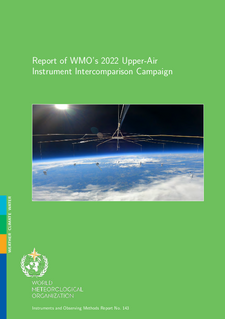Report of WMO’s 2022 Upper-Air Instrument Intercomparison Campaign
IOM-143
Details
- ID
IOM-143
- Title
Report of WMO’s 2022 Upper-Air Instrument Intercomparison Campaign
- Publisher
World Meteorological Organization (WMO)
- Last version
v1.0 (2024-03)
- Status
Published
- Download
- Link
Abstract
Upper air instrument intercomparisons (Upper-Air Instrument Intercomparison) are important to periodically assess the performance of upper air measurement systems, in particular radiosondes, and to support WMO Members in the design of their upper air networks. The focus of the WMO Upper-Air Instrument Intercomparison 2022 (UAII 2022) was set on upper air systems with operational maturity. These are ideally used by national meteorological services to send data to the Global Telecommunication System (GTS). The UAII 2022 took a new approach to such intercomparisons to obtain results of best possible general validity:
- A laboratory campaign for radiosondes complemented the field campaign and provided valuable insight in the behaviour of radiosondes under laboratory conditions;
- The use of a well characterised working measurement standard based on GCOS Reference Upper Air Network (GRUAN) data products and a fully documented and objective data analysis yields transparent and traceable results;
- Independent operators for the radiosondes make the results representative for operational use and allowed the assessment of user friendliness as an added value;
- Besides radiosondes, UAII 2022 includes a suite of surface based remote sensing upper air systems to give a more complete picture of the performance of upper air systems.
Radiosonde models from manufacturers based in China (2), Finland (1), France (1), Germany (1), India (2), Japan (1), South Africa (1), and Republic of Korea (1) participated in the UAII 2022. The participating radiosonde models represent almost half of the radiosonde data exchanged on the GTS at the time of writing. Due to the conflict between the Russian Federation and Ukraine, no manufacturers from the Russian Federation participated in the intercomparison. Upper-Air Instrument Intercomparison 2022 was co-hosted by Deutscher Wetterdienst (Deutscher Wetterdienst) and MeteoSwiss (MeteoSwiss), with DWD’s Lindenberg Meteorological Observatory as campaign site. The field campaign was performed during a mid-latitude summer offering an atmospheric temperature range of −65 °C to 33 °C. The main dataset (on which the conclusions are based) consists of data collected from a total of 79 balloon soundings during the field campaign. Taking into account the measurement uncertainty of the working measurement standard, the upper air systems are evaluated against the uncertainty requirements defined in WMO’s OSCAR database for various application areas. This approach yields a detailed assessment of the performance of the different systems and is of added value to WMO Members. For numerical weather prediction and related applications, very good performance is observed for temperature and wind: most systems meet the respective breakthrough requirements. Good performance is observed for humidity: most systems meet the respective threshold requirements. OSCAR requirements for climate applications are the most stringent ones and are challenging to meet. This particularly applies to humidity measurements, where there is a large gap between current systems’ capabilities and the OSCAR requirements. Despite a careful analysis methodology, the readers of this report should be aware of the limitations of the presented results. The GRUAN data products are objectively a good choice for the working measurement standard, in particular because their measurement uncertainties are well characterised. And although they are the community’s best-effort for providing reference observations, they are not guaranteed to represent the absolute truth. Furthermore, although the field campaign allowed the sampling of a wide range of atmospheric temperatures, it did not cover the more extreme atmospheric conditions found in tropical or polar regions.
